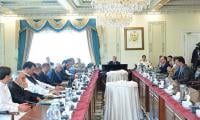KARACHI: Pakistan’s public debt rose 9.25 percent or 2.24 trillion rupees to Rs26.452 trillion in the first five months of the 2018/19 fiscal year as the government continued to rely on domestic and external borrowings to meet its financing needs.
Public debt amounted to Rs24.212 trillion by end-June last year. Debt increased 21 percent to Rs21.860 trillion till November last year, the central bank’s data showed on Monday.
The first four months of the incumbent Pakistan Tehreek-e-Insaf (PTI) government had seen a continuous deterioration in the country’s debt profile. From August to November 2018, the total public debt increased almost 7 percent to Rs26.452 trillion.
A significant accumulation in public debt was contributed by both, domestic and foreign debts. Domestic debt amounted to Rs17.322 trillion at the end of November, compared with Rs16.416 trillion in June last year, the State Bank of Pakistan (SBP) date showed. The government frequently heavily borrowed funds from the commercial banks as well as from the SBP to finance its budget deficit.
Analysts said loss-making public sector enterprises pushed the stocks of domestic debt. Financial losses by state-owned airlines, steel mills and a huge circular debt of the power firms caused sizeable demand for the budgetary resources, they added.
Foreign debt stood at Rs9.129 trillion at the end of November FY19, compared with Rs7.795 trillion in June FY18. A bulk of the rise in external debt stemmed from loans from China, foreign commercial banks and proceeds from Eurobond/Sukuk issuance, and currency depreciation. The rising macroeconomic imbalances, the widening of twin deficits in particular, quickened the pace of debt accumulation, the SBP said in its annual report for FY17/18 published in October.
“The gross public debt rose by 5.6 percentage points to 72.5 percent of GDP by end-June 2018. The debt-to-GDP ratio remained higher than the 60 percent limit envisaged in the Fiscal Responsibility & Debt Limitation Act (FRDLA), 2005,” the report said.
The government held talks with the International Monetary Fund (IMF) in November last year for a bailout package to ease pressure on the balance of payments, which remained inconclusive amid the Fund’s tough demands for securing the new programme. The keys preconditions for the IMF bailout seem to be lower budget deficit and transparency about the extent, composition of and terms of the country’s all debts, especially debts to China under China-Pakistan Economic Corridor (CPEC).
Analysts expect fiscal deficit to clock in at 5.7 percent in FY19 versus government’s target of 5.2 percent. They also see new fiscal measures on the cards. Major focus areas in order to contain fiscal deficit at 5 percent are likely to be reduction in subsidies, cut down in spending on social support, possibility of new corporate tax, or additional tax on banks, and increase in general sales tax.
The headquarters of the Sui Southern Gas Company . — APP FileKARACHI: Sui Southern Gas Company has launched a fresh...
The logo of the ExpoMed Eurasia. — CA MI websiteKARACHI: Pakistan is participating in ExpoMed Eurasia, a leading...
Gold bars are seen in this undated file photo. — AFP/FileKARACHI: Gold prices increased by Rs500 per tola on...
FFBL Head Office building can be seen in Islamabad. — FFBL WebsiteKARACHI: Fauji Fertilizer Bin Qasim Limited has...
Representational file of an BMW car. — AFP FileLAHORE: Small improvements in economic credentials of the country are...
A fuel station worker filling petrol in vehicle at a fuel station in Karachi on Tuesday, April 16, 2024KARACHI: After...







